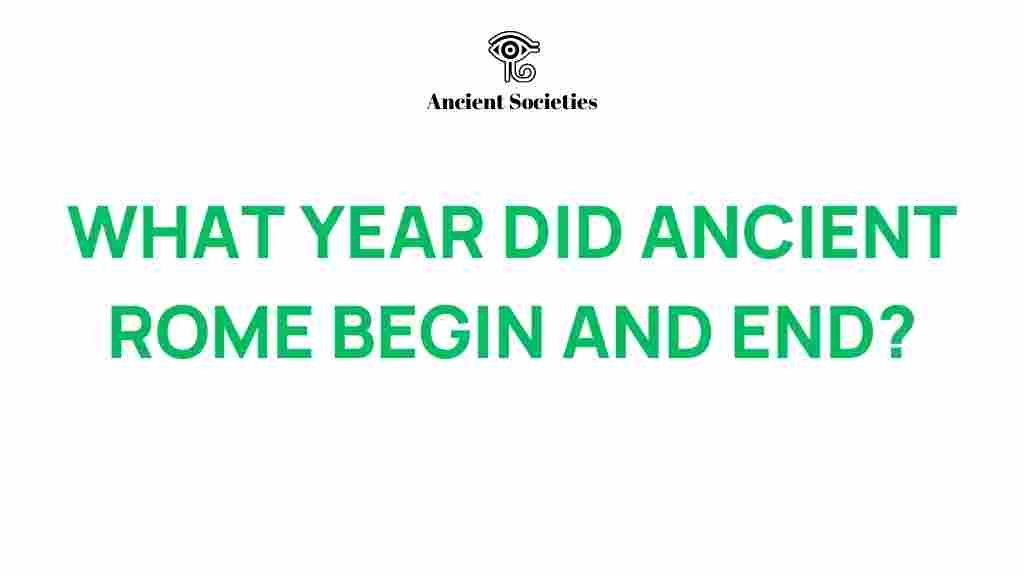Ancient Rome: A Timeline of Power
The story of Ancient Rome is one of triumph, culture, and ultimately, decline. As one of the greatest empires in history, it has left an indelible mark on the world we know today. This article will explore the rise and fall of this remarkable civilization, providing a detailed timeline that highlights key events and cultural milestones that shaped the Roman Empire.
Introduction to Ancient Rome
The history of Ancient Rome is often divided into three main periods: the Roman Kingdom, the Roman Republic, and the Roman Empire. Each era reflects the evolution of Roman power and culture, showcasing the civilization’s ability to adapt and expand. The rise of Rome is marked by significant achievements in governance, architecture, and art, while its decline is a cautionary tale of political strife, economic turmoil, and external pressures.
Timeline of Ancient Rome: Key Events
1. The Roman Kingdom (753-509 BC)
The history of Ancient Rome begins with its legendary founding in 753 BC. According to tradition, Romulus, the first king, established the city after a series of events involving the abduction of the Sabine women.
- 753 BC: Founding of Rome by Romulus.
- 509 BC: End of the monarchy; establishment of the Roman Republic.
2. The Roman Republic (509-27 BC)
The Roman Republic was characterized by a complex system of government that included elected officials and checks on power. This period saw Rome expand its influence across the Mediterranean.
- 264-146 BC: The Punic Wars against Carthage solidified Roman dominance.
- 49 BC: Julius Caesar crosses the Rubicon, leading to a civil war.
- 44 BC: Assassination of Julius Caesar; the Republic begins to unravel.
3. The Roman Empire (27 BC-476 AD)
With the rise of Augustus in 27 BC, Rome transitioned from a republic to an empire, marking the beginning of a new era characterized by relative peace known as the Pax Romana.
- 27 BC: Augustus becomes the first Roman Emperor.
- 117 AD: The empire reaches its greatest territorial extent under Emperor Trajan.
- 284 AD: Diocletian becomes emperor and divides the empire for better management.
- 476 AD: Fall of the Western Roman Empire; the last emperor, Romulus Augustulus, is deposed.
Culture and Society in Ancient Rome
The culture of Ancient Rome was a rich tapestry woven from various influences, including Greek, Etruscan, and local Italic traditions. Roman society was highly stratified, with a clear distinction between patricians (aristocratic families) and plebeians (commoners).
Key Aspects of Roman Culture
- Religion: Polytheism was prevalent, with gods such as Jupiter and Mars being worshiped.
- Architecture: Innovations such as the arch and concrete allowed for grand structures like the Colosseum and aqueducts.
- Language: Latin became the lingua franca of the Roman Empire and influenced many modern languages.
- Law: The Twelve Tables established the foundation of Roman law, influencing legal systems worldwide.
Factors Leading to the Decline of Ancient Rome
The decline of the Roman Empire was not the result of a single event but rather a combination of internal and external factors that accumulated over centuries.
Internal Factors
- Political Corruption: Ineffective leadership and corruption weakened the central authority.
- Economic Troubles: Heavy taxation, reliance on slave labor, and inflation destabilized the economy.
- Military Issues: The reliance on mercenaries and a lack of discipline among troops led to military failures.
External Factors
- Barbarian Invasions: Groups such as the Visigoths and Vandals invaded and sacked Rome.
- Loss of Territory: The empire struggled to maintain its vast borders, losing provinces to invading forces.
- Division of the Empire: The split into Eastern and Western Roman Empires diluted resources and focus.
Conclusion: The Legacy of Ancient Rome
The fall of Ancient Rome marked the end of a remarkable era in history. Despite its decline, the legacy of the Roman Empire continues to influence modern society. From law and governance to architecture and language, the contributions of this ancient civilization remain relevant today.
For those interested in exploring more about the fascinating history of Ancient Rome, consider visiting History.com for in-depth articles and resources.
As we reflect on the rise and fall of the Roman Empire, we can learn valuable lessons about the dynamics of power, the importance of stable governance, and the need for adaptability in the face of changing circumstances. The timeline of Ancient Rome serves as both a chronicle of achievements and a reminder of the vulnerabilities that civilizations face.
For further reading on related topics, check out our article on the Cultural Impact of Ancient Civilizations.
This article is in the category History and created by AncientSocieties Team
